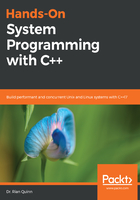
上QQ阅读APP看书,第一时间看更新
Filesystems
POSIX not only defines how to read and write a file from a POSIX-compliant operating system, it also defines where files should be located on the filesystem. In Chapter 8, Learning to Program File Input/Output, we will go into great detail about how to read and write to a filesystem using C, C++, and POSIX.
With respect to the layout of the filesystem, POSIX defines where files should be located, including common folders such as the following:
- /bin: for binaries used by all users
- /boot: for files needed to boot the operating system
- /dev: for physical and virtual devices
- /etc: for configuration files needed by the operating system
- /home: for user-specific files
- /lib: for libraries needed by executables
- /mnt and /media: used as temporary mount points
- /sbin: for system-specific binaries
- /tmp: for files that are deleted on reboot
- /usr: for user-specific versions of the preceding folders